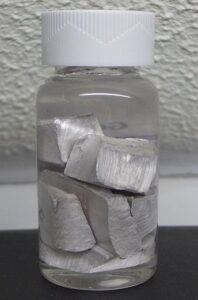Table of Contents
Lassaigne’s test determines nitrogen, sulphur, and halogens in organic compounds. In this experiment, a tiny chunk of Na metal is heated in a fusion tube alongside the organic compound.

The basic idea is that Na converts all of the elements present into ionic form.
That is, Na + C + N → NaCN
2Na + S → Na2S
Na + X → NaX ( X= Cl, Br, or I)
Boiling the fused mass with distilled water extracts the formed ionic salts. Is thus known as sodium fusion extract.
Lassaigne Test Procedure
Lassaigne’s test, as well known as the sodium fusion test, is often used in elemental analysis to calculate the presence of foreign compounds, specifically Halogens, Nitrogen, and Sulphur, in an organic compound.
Lassaigne developed this procedure. One such experiment involves roughly boiling the sample with pure sodium metal and fusing it with the solution.
Many different types of methods have been defined. The water aids in the emergence of the “fused” sample within it, and the usual conditional trials are carried out on the subsequent solution for the specific possible constituents.
There really is a method for determining the presence of a halogen, nitrogen, or sulphur in an organic solution. In a test tube with a bit of sodium, a model would be excited with heat. The boiling tube has been immersed in pure water, and the wreckages are thoroughly coated in an adhesive.
The presence of halogen could be detected by precipitating it with silver nitrate solution.
The presence of nitrogen could be revealed by the formation of a Prussian blue precipitate on the warming portion of the solution with iron.
The precipitation of Lead Ethanoate or Sodium Nitroprusside indicates the presence of sulphur.
Test for Nitrogen
The extract has been acidified with concentrated H2SO4 after being boiled with FeSO4. The presence of nitrogen is indicated by the appearance of Prussian blue colour.
The following reactions take place:
Fe2+ + 6CN– → [Fe(CN)6]4-
Fe2+ + H+→ Fe3+ + e–
[Fe(CN)6]4- + 4Fe3+ → Fe4[Fe(CN)6].H2O
The acid promotes the conversion of ferrous ions to ferric ions. The presence of nitrogen has been indicated by the formation of ferriferous cyanide.
Test for Sulphur
Sodium nitroprusside is being used to treat the extract. The presence of sulphur has been indicated by the appearance of violet colour.
The following reaction will take place:
S2- + [Fe(CN)5NO]2- → [Fe(CN)5NOS]4-
Test for Halogens
The extract has been acidified with HNO3 before being treated with AgNO3. A white precipitate that really is soluble in NH4OH indicates the presence of Cl, a yellowish precipitate that is only slightly soluble in NH4OH indicates the presence of Br, and a yellow precipitate that is insoluble in NH4OH indicates the presence of I.
AgNO3 + NaX → AgX ↓ + NaNO3
FAQs
Why do we use sodium metal in the Lassaigne Test?
The utilisation of sodium metal has been due to the fact that this metal reacts with the elements currently present in organic compounds to produce inorganic compounds.
What is the reason behind keeping metallic sodium in Kerosene?
Potassium and sodium, since we all know, were indeed extremely sensitive metals. They interfere so vigorously with the carbon dioxide, oxygen, and moisture in the air that they may even be the cause of the fire. The least harmful way to store sodium is in kerosene, which does not react with the metal.



